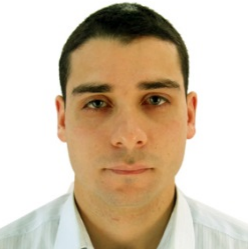International Journal of Information Technology and Computer Science (IJITCS)
IJITCS Vol. 8, No. 10, 8 Oct. 2016
Cover page and Table of Contents: PDF (size: 623KB)
Interference Rejection in FH/BFSK System Using Blind Source Separation
Full Text (PDF, 623KB), PP.47-55
Views: 0 Downloads: 0
Author(s)
Index Terms
Blind source separation, frequency hopping, interference rejection, spread spectrum
Abstract
This paper introduces a new approach based on blind source separation (BSS) to mitigate intentional interference in BFSK digital communication systems using frequency hopping spread spectrum technique. The use of BSS is possible thanks to adopting an adequate selection block to distinguish between the useful signal and other undesirable signals, hence, circumvent the problem of ambiguity of permutation. An analytical calculation of the probability of error to predict the performance is done. The simulation results showed the effectiveness of this approach, whatever the level of the JSR and without using the fast frequency hopping alternative or error-correcting codes.
Cite This Paper
Rafik Guellil, Hadj Abd El Kader Benzater, Mustapha Djeddou, "Interference Rejection in FH/BFSK System Using Blind Source Separation", International Journal of Information Technology and Computer Science(IJITCS), Vol.8, No.10, pp.47-55, 2016. DOI:10.5815/ijitcs.2016.10.06
Reference
[1]T. Salonidis, P. Bhagwat, L. Tassiulas, and R. LaMaire. Distributed topology construction of bluetooth wireless personal area networks. IEEE Journal on Selected Areas in Communications, 23:633–643, Mar 2005.
[2]L. Simone, N. Salerno, and M. Maffei. Frequency-hopping techniques for secure satellite TT&C: system analysis & trade-offs. IEEE International Workshop on Satellite and Space Communications, pages 13–17, Sept 2006
[3]M. Pursley. Frequency-hop transmission for satellite packet switching and terrestrial packet radio networks. IEEE Transactions on Information Theory, 32:652–667, Sept 1986.
[4]H. M. Kwon, L. E. Miller, and J. S. Lee. Evaluation of a partial-band jammer with Gaussian-shaped spectrum against FH/MFSK. IEEE Transactions on Communications, 38:1045–1049, July 1990.
[5]C. Jiang and J. Wang. Multitone interference of fast FH/MFSK systems over Rician fading channels. IEEE Transactions on Communications, 1:309–313, May 1999.
[6]K. C. Teh, A. C. Kot, and K. H. Li. Performance study of a maximum-likelihood receiver for FFH/BFSK systems with multitone jamming. IEEE Transactions on Communications, 47:766–772, May 1999.
[7]J. J. Chang and L. S. Lee. An exact performance analysis of the clipped diversity combining receiver for FH/MFSK systems against a band multitone jammer. IEEE Transactions on Communications, 42:700–710, Feb 1994.
[8]R. Viswanathan and K. Taghizadeh. Diversity combining in FFH/BFSK systems to combat partial band jamming. IEEE Communications Letters, 36:1062–1069, Sept 1988.
[9]F. Eken. Use of antenna nulling with frequency-hopping against the follower jammer. IEEE Transactions on Antennas Propagation, 39:1391–1397, Sept 1991.
[10]C. C. Ko, H. Nguyen-Le, and L. Huang. ML-based follower jamming rejection in slow FH/MFSK systems with an antenna array. IEEE Transactions on Antennas Propagation, 56:1536–1544, Sept 2008.
[11]A. M. Alaa, H. Tawfik, Interference Mitigation Techniques for Spectral Capacity Enhancement in GSM Networks, IJWMT, vol.4, no.1, pp.20-49, 2014. DOI: 10.5815/ijwmt.2014.01.03
[12]M. F. Ghanim, M. F. L. Abdullah, Analysis of MC-CDMA System in Mobile Communications, IJITCS, vol.4, no.12, pp.87-94, 2012.
[13]A. Belouchrani and Moeness G. Amin. Jammer mitigation in spread spectrum communications using blind source separation. Signal Processing, 80 (723-729), 2000.
[14]A. Belouchrani, K. Abed-Meraim, J. Cardoso, and E. Moulines. A Blind Source Separation Technique Using Second-Order Statistics. IEEE Transactions On Signal Processing, 45:4, February 1997.
[15]J.-F. Cardoso and A. Souloumiac. Blind beamforming for non-gaussian signals. IEEE processing, 140:362–370, 1993.
[16]R. Mukai, S. Araki, and S. Makino. Separation and dereverberation performance of frequency domain blind source separation for speech in a reverberant environment. Proceeding of Eurospeech 2001, pages 2599–2603, 2001.


